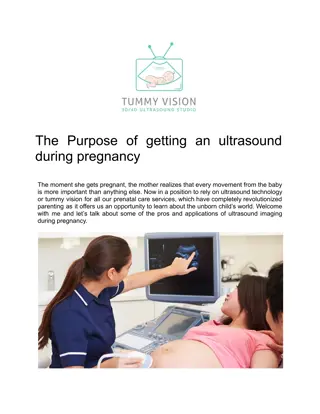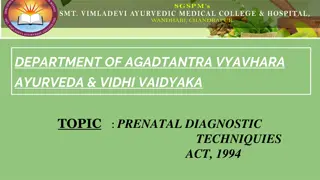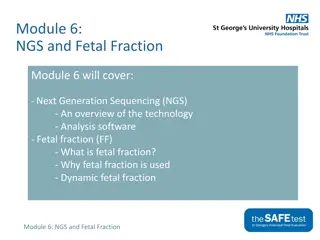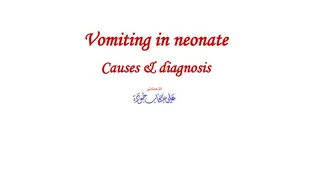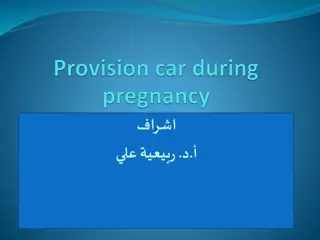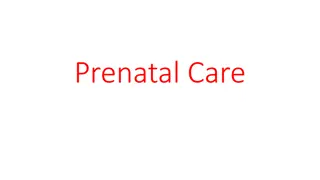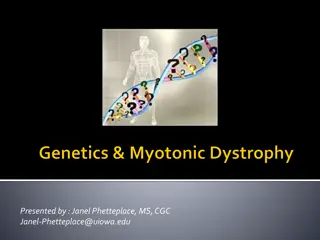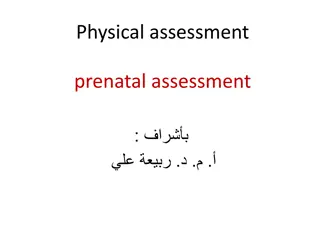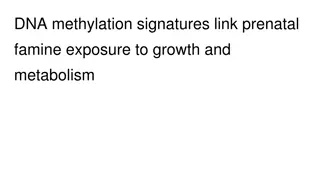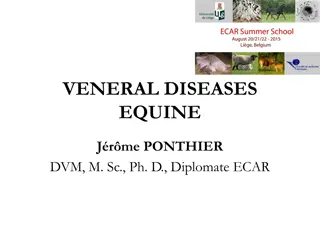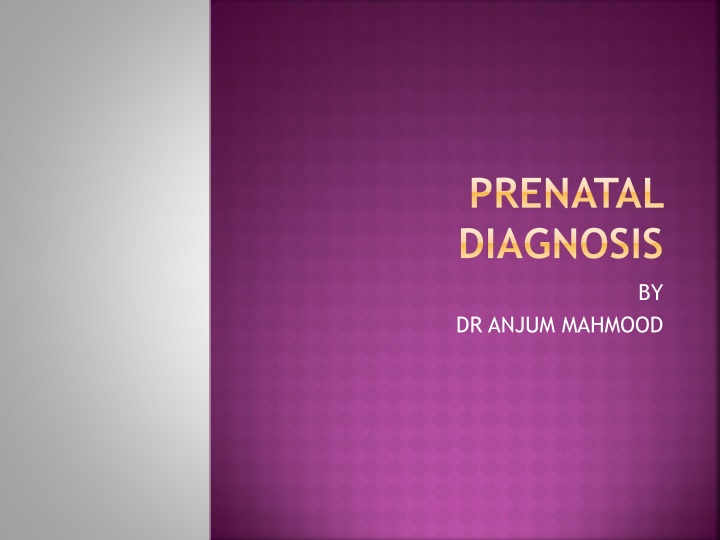
Prenatal Diagnosis for Genetic Conditions
Explore the world of prenatal diagnosis with Dr. Anjum Mahmood, focusing on identifying genetic diseases in fetuses before birth. Discover the importance, types of tests, indications, benefits, and classifications of congenital abnormalities. Learn about fetal medicine, diagnostic techniques, and newer advancements in this field.
Download Presentation

Please find below an Image/Link to download the presentation.
The content on the website is provided AS IS for your information and personal use only. It may not be sold, licensed, or shared on other websites without obtaining consent from the author. If you encounter any issues during the download, it is possible that the publisher has removed the file from their server.
You are allowed to download the files provided on this website for personal or commercial use, subject to the condition that they are used lawfully. All files are the property of their respective owners.
The content on the website is provided AS IS for your information and personal use only. It may not be sold, licensed, or shared on other websites without obtaining consent from the author.
E N D
Presentation Transcript
PRENATAL DIAGNOSIS BY DR ANJUM MAHMOOD
LEARNING OBJECTIVES To understand what is prenatal diagnosis Why is it performed To be able to classify different types of prenatal diagnostic tests To know about the conditions where prenatal diagnosis is important To learn about some newer techniques of prenatal diagnosis
PRENATAL DIAGNOSIS Identification of a disease in the fetus before birth Over the last 4 decades, the genetic basis of an increasing number of diseases is becoming understood. At the same time, safe and effective fetal diagnostic techniques are being developed.
FETAL MEDICINE Only in the past few decades has the fetus been considered a patient and become the subject of extensive scientific study and attempts at treatment. Fetal medicine is a complex multidisciplinary undertaking with a team and has 2 aspects Fetal diagnosis Fetal Therapy 1) 2)
INDICATIONS FOR PERFORMING PRENATAL TESTS Family hx of a genetic disease Previous obstetric hx of fetal anamoly , either structural or chromosomal Maternal age Rh incompatibility Parental chromosomal abnormalities such as balanced translocation, inversion etc leading to recurrent pregnancy loss
PRENATAL DIAGNOSIS Benefits: Malformation incompatible with life may be terminated. Certain abnormalities may be correctible in-utero. -Provides opportunity to arrange corrective measures before hand. - offer a chance to be delivered at a place where the required facilities are available. 4. Parents decision to continue pregnancy/ mentally prepare to have a handicapped child. 1. 2. 3.
CLASSIFICATION OF CONGENITAL ABNORMALITIES Chromosomal Abnormalities: - Trisomy 21 (D.S) - Trisomy 18 1 (E.S) - Trisomy 13 (P.S) Structural Abnormalities: - CNS CVS GIT Bone Renal system 2 - - - - Genetic Disorders: - Inborn error of metabolism - Haemoglobinopathies 3
CAUSES OF CONGENITAL ANOMALIES
TYPES OF TESTS Screening procedures Definite / Diagnostic tests for screened positive cases Screening tests are not definitive , they only provide information regarding the risk of a fetus having a certain disorder Diagnostic tests are definitive and identify the defect or disorder in fetus
SCREENING PROCEDURES Should be : Simple Cheap Least invasive Safe Easily repeatable Readily available for all
TYPES OF SCREENING PROCEDURES History and clinical examination Ultrasonography at 12 weeks dating scan or 20 weeks anamoly scan Cell free DNA screening Serum screening tests
PRE-NATAL SCREENING PROCEDURES History Taking Abnormal findings during routine examination Abnormal findings during routine investigations Specific Antenatal screening procedures 14
SCREENING PROCEDURES --- CONT. 1. History: - Increasing maternal age - Congenital anomalies in previous children - Family Hx. . Still birth . Recurrent 1st trimester abortion . Cousin marriage
SCREENING PROCEDURES ---CONT. 2. Features of current pregnancy: - Drug intake(antiepileptics e.g. warfarin, alcohol, smoking) - Radiation exposure - Maternal chronic diseases e.g.DM, cardiac, renal - Uterine fundus large/ small for date - Decrease fetal movements - Fetal malpresentation - Viral infection in early pregnancy
ABNORMAL FINDINGS ON CLINICAL EXAMINATION A higher incidence of congenital anomalies are detected in association with : Oligohydramnious: renal dysplasia, renal agenesis, bladder outlet obstruction and intrauterine growth retardation. Polyhydramnios: Central nervous system anomalies Gastrointestinal malformations Threatened abortion. Unexplained IUGR. 17
SCREENING PROCEDURES --- CONT. 3. Ultrasonography: - Screening tool in all trimesters - At 10-14 weeks if fetal nuchal translucency - > 2.5 mm- chromosomal anomalies association - At 18-20 weeks 75% fetal abnormalities can be diagnosed
ABNORMAL FINDINGS ON ROUTINE INVESTIGATIONS Suspicious findings on ultrasound screening: Early IUGR IUGR Oligohydramnios Poly Hydramnios Restricted fetal movements 19
1STTRIMESTER ULTRASOUND NT Ultrasound
SPECIFIC PRENATAL SCREENING PROCEDURES Measurement of maternal serum alpha fetoprotein level. The triple test . Specific prenatal techniques.
SCREENING PROCEDURES ---CONT. 4. Maternal blood tests: - Maternal Serum alpha fetoproteins: produced by . Yolk sac in first trimester . Liver in second and third trimester . Normally increase from 12-32 weeks . Abnormally raised at fetal capillaries exposure to amniotic fluid e.g. in NTD.
During pregnancy MSAFP is elevated in: neural tube defects abdominal wall defects e.g. omphalocele esophageal or intestinal obstruction cystic hygroma urinary obstruction renal anomalies polycystic kidneys osteogenesis imperfecta Turner s syndrome Rh disease low birth weight oligohydramnios multifetal gestation. 27
During pregnancy MSAFP is abnormally low : Chromosomal trisomies . Gestational trophoblastic disease. intrauterine fetal death.
CELL FREE DNA Can be extracted from maternal blood It determines fetal blood group It is used in cases of RH incompatibility Also used to determine fetal sex in X linked disorders Used to diagnose skeletal dysplasias eg achondroplasia
THE TRIPLE TEST Specified combinations of maternal serum assay of AFP b HCG Unconjugated estriol
TRIPLE TEST - Used for Down Synd. Screening. - Best carried at 15-18 weeks. - Triple test+ maternal age diagnose 60% DS - In trisomy 18 all components are low
QUADRUPLE TEST Triple test+ Inhibin A estimation This test + maternal age detects 76% cases of downs syndrome
DOUBLE TEST Low pregnancy associated plasma proteins-A (PAPP-A) level and raised serum Beta-hCG during 1st trimester Double test+ maternal age diagnose 60% DS.
DIAGNOSTIC TESTS For high risk women on basis of screening tests An ideal test should be : - Least invasive - diagnose c. abnormality in early pregnancy. - Minimally interfering developing pregnancy Diagnostic tests are also not risk free.
DIAGNOSTIC PRENATAL TECHNIQUES Non-invasive techniques: Malformation ultrasound scan (Anomaly scan) MRI. Invasive techniques: Amniocentesis Chorionic villous sampling (CVS), Cordocentesis, Fetoscopy Tapping of fluid filled fetal structure e.g. collection of fetal urine for assessment of the renal function. 35
ANOMALY SCANS Structural Assessment: Systematic documentation of the essential fetal anatomy: head, neck, chest, abdomen, limbs, external genitalia, Assessment of amniotic fluid volume. The umbilical cord and its vessels. Measurements are calculated (Biometry): The most significant measurements are BPD (biparietal diameter), OFD (occipto-frontal diameter), HC (head circumference), and FL (femur length) 36
NUCHAL TRANSLUCENCY SCAN Performed between 11.5 and 13 .5 weeks as part of first trimester screening. Indications: Down Syndrome Turner syndrome Trisomy 18 Trisomy 13 Triploidy
NON INVASIVE TESTS Ultrasonography: Diagnostic USG is different from screening USG, - It takes longer time - Dx. Wide range of c. anomalies Colour doppler further enhance the capability especially for cardiac malformations and renal agenesis.
OTHER SOFT SIGNS short ears cerebellar hypoplasia cholecystomegaly Mild cerebral ventriculomegaly Hypoplasia of middle phalanx of 5th digit Increased iliac angle Short frontal lobe
INVASIVE TESTS Counselling It is mandatory before doing diagnostic invasive tests . Women choose to have or not to have these tests. It is an important decision with life long impact hence it should be an informed decision The doctor must be aware of the condition suspected and the possible outcomes of the test
COUNSELLING Organize an appointment Couple should be present Explain: - Risk of occurance of cong. abnormality - All tests available, their procedure, cost, diagnostic ability and benefits, possible risks - Possible management plan If termination of pregnancy is unacceptable diagnostic tests would be fruitless. Ethics and religious belief should also be respected
INVASIVE TESTS AMNIOCENTESIS: Aspiration of amniotic fluid which contain fetal somatic cells Fluid can be used for estimation of - bilirubin level (for fetal haemolytic disease). - AFP -Acetyl cholinesterase Cells used for karyotyping (Chromosomal dis.) Fetal cells-cultured for 3 weeks- karyotyping. New technique-PCR give result in 48 h. Preferred time of test 16weeks of pregnancy.
AMNIOCENTESIS Indications of amniocentesis Chromosomal abnormality open neural tube defect inborn error of metabolism. 47
AMNIOCENTESIS---CONT. Procedure: Preliminary USG to confirm-duration of gestation, - placental site,- adequacy of liqour (150-200 ml) Sterilize the abdomen 22 G spinal needle is used. About 20 cc amniotic fluid is withdrawn. Give Anti- D to all Rh-ve mothers. Ask rest for 30 min. restrict movements for 48h
RISKS OF AMNIOCENTESIS o Pregnancy loss 1% o Procedure failure 0.5% o Bleeding o Infection o Prom o Leaking o IUD o Increased incidence of RDS in newborn 50


